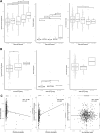Novel Artificial Intelligence-Based Quantification of Anterior Chamber Inflammation Using Vision Transformers
- PMID: 40434370
- PMCID: PMC12126123
- DOI: 10.1167/tvst.14.5.31
Novel Artificial Intelligence-Based Quantification of Anterior Chamber Inflammation Using Vision Transformers
Abstract
Purpose: Quantitative assessment of inflammation is critical for the accurate diagnosis and effective management of uveitis. This study aims to introduce a novel three-dimensional vision transformer approach using anterior segment optical coherence tomography (AS-OCT) to quantify anterior chamber (AC) inflammation in uveitis patients.
Methods: This cross-sectional study was conducted from January 2022 to December 2023 at a single tertiary eye center in Singapore, analyzing 830 AS-OCT B-scans from 180 participants, including uveitis patients at various stages of inflammation and healthy controls. The primary outcomes measured were central corneal thickness (CCT), Iris Vascularity Index (IVI), and Anterior Chamber Particle Index (ACPI). These parameters were assessed using the Swin Transformer V2 artificial intelligence algorithm on AS-OCT images.
Results: The study included 180 participants, including uveitis patients and healthy controls. We observed significant differences between these groups in CCT (P = 0.01), ACPI (P < 0.001), and IVI (P < 0.001). Affected eyes showed elevated CCT and ACPI, along with a significant decrease in IVI, especially in severe inflammation cases. Linear regression analysis underscored a robust correlation between these biometric parameters and inflammation severity in the AC (R = 0.481, P < 0.001). A 6-month longitudinal study further validated the stability and repeatability of these measurements, affirming their reliability over time.
Conclusions: This study introduces a novel, objective method to quantify ocular inflammation using ACPI, IVI, and CCT, which enhances the precision of assessments over traditional subjective methods prone to interobserver variability. Demonstrated through significant biomarker stability over a 6-month period, our findings support the use of these metrics for reliable long-term monitoring of inflammation progression and treatment efficacy in clinical practice.
Translational relevance: Our artificial intelligence algorithm objectively quantifies AC inflammation reliably over the time and could be used in the clinic as well as in clinical trials as an objective biomarker.
Conflict of interest statement
Disclosure:
Figures




References
-
- Whitcup SM, Sen HN. Whitcup and Nussenblatt's Uveitis. New York: Elsevier; 2022, doi:10.1016/C2014-0-04249-9. - DOI
MeSH terms
LinkOut - more resources
Full Text Sources
Research Materials

